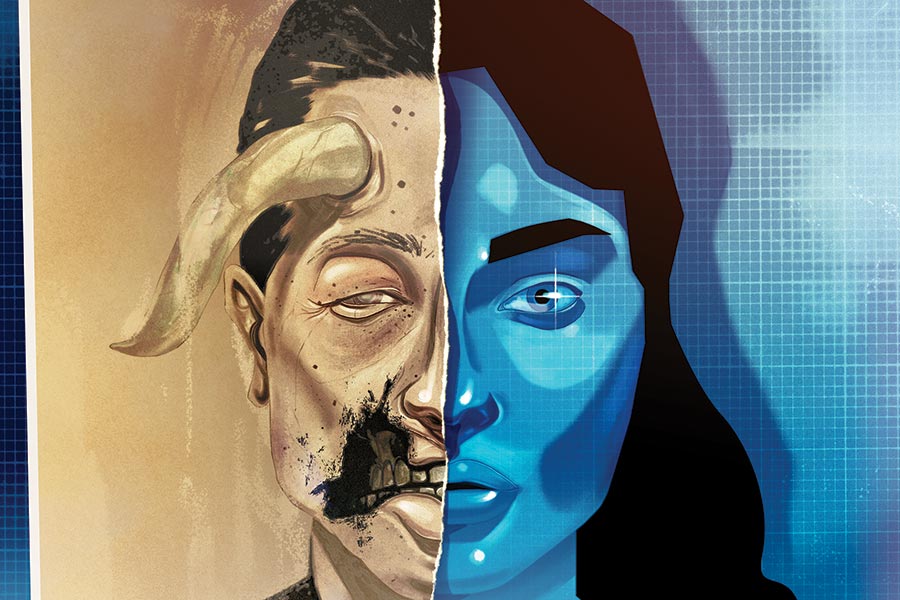Freaks and Geeks
What’s “normal”? And is it something we should all aspire to be?

Illustration by Jonathan Bartlett
Back in August, this magazine moved its offices from 19th and Market to the Curtis Center at 6th and Walnut, home for decades to the publisher of the Saturday Evening Post and other journalistic stalwarts. All of us staffers had adjustments to make. The new digs are an “open office,” with no doors to close against your neighbor’s god-awful cold or anxious calls to day care. We’re on the second floor, whereas we used to be on the 36th. And I had to find a new parking garage. The one I settled on, at 10th and Walnut, costs $50 less per month than its Center City cousin, which made me happy. Yet in the first few weeks, as I pounded the pavement to and from the office in late summer, I found my mood decidedly downbeat. I’m naturally a pretty sunny person, and it took a while for me to pinpoint the source of this discontent: My new route to work runs through a medical Mecca.
In just the few blocks of Walnut Street between 6th and 10th, I pass nearly half a dozen Jefferson Hospital buildings, Wills Eye Hospital, a dialysis clinic, a Penn obstetrics clinic, a sleep disorder center, and a library for the blind and physically handicapped, among other therapeutic enterprises. Traffic is an odd mix of cutthroat and magnanimous; SEPTA buses pause for blind patrons tapping canes across intersections while taxis careen around folks in wheelchairs strapped with oxygen tanks. Vans are always double-parking to disgorge the frail and elderly and suffering, helped by aides and drivers out into the babble of the city. The sidewalks are lined with — is there a more P.C. term? — beggars, bearing paper cups and their cardboard signs asking for mercy from me.
On a charitable scale, I like to think I register above average. But after a month of trekking through this daily parade, I could feel my compassion fraying at the seams. No one minds waiting for one visually impaired person to navigate the sidewalk, but three? Five? Eight? At some point, you find yourself wishing they’d just go away.
And then are appalled at your heartlessness.
And you start to think: For most of human history, the world was like this little stretch of Calcutta, teeming with the lame, the maimed, the scarred, the limbless, the sightless and the, well, insane. Which makes that history pretty much a charting of the same relentless cycle of resentment and clemency I now go through twice a day.
There are evolutionary reasons for the revulsion we feel when confronted with visibly imperfect humans: We don’t want to be contaminated. The biblical book of Leviticus has a lot to say about people with disabilities:
And the Lord spoke to Moses, saying, “Speak to Aaron, saying, None of your offspring throughout their generations who has a blemish may approach to offer the bread of his God. For no one who has a blemish shall draw near, a man blind or lame, or one who has a mutilated face or a limb too long, or a man who has an injured foot or an injured hand, or a hunchback or a dwarf or a man with a defect in his sight or an itching disease or scabs or crushed testicles. … ”
That’s a pretty hefty list. There’s more, too: The Leviticus writers took pains to describe different skin diseases and lay out the varying periods of isolation from the tribe they required: a fortnight for a shiny white spot; seven days for a boil or a sore on the head. Those affected had to rend their clothes, cover their faces, and “live alone, outside the camp.” Contemporary researchers have correlated these biblical descriptions with illnesses: leprosy, psoriasis, ringworm, impetigo, scrofula. The separation from society was meant to prevent disease from spreading, but it also created outcasts, those whose conditions were seen as punishments from God.
In the New Testament, in contrast, Jesus spends much time healing the “multitude of those who were sick, blind, lame, and withered.” This wasn’t just to make daily life easier for them; it was to pronounce them worthy — to bring them back into the social fold. Despite this example, those with disabilities continued to be shunned and feared, considered “monsters” — the word, derived from the Latin for “omen,” originally meant one who deviated from the norm in appearance or behavior, which is to say the whole amplitude of dwarfs, giants, the withered, the marred, those lacking limbs or with cleft lips or clubbed feet. If we weren’t blaming defects on God or demon-possession, we were accusing the mothers: Baby born extra-hairy? You must have seen a scary wolf! Birthmarked? You should have eaten those strawberries you craved!
Besides conditions present from birth, there were the effects of polio and smallpox, tuberculosis, syphilis, scurvy, plague. (Our word “quarantine” is derived from the 40 days ships were required to wait in port before passengers and crew could go ashore during the Black Death.) Disease was often horribly disfiguring; wounds and burns suppurated; limbs were lost to household and agricultural accidents, not to mention wars. A petition to Henry VIII in 1538 objected to “the miserable people lyeing in the streete, offending every clene person passing by the way.” Some of the crippled and lame and unwhole and lunatic lived with their families, some were cared for by religious institutions, but many were homeless and ostracized. A jolly French custom was to drive the mad and maimed out of town with sticks.
The Enlightenment left people less inclined to blame disability on God, but also more likely to subject the disabled to charity, which meant rounding them up and storing them in institutions on the outskirts of towns, where they could be ignored by the rest of the populace. (This also had the salutary effect of freeing up their caregivers for the Industrial Revolution labor force.) In his book Madness & Civilization, Michel Foucault wrote that the “enormous houses of confinement” built in France in the 17th century resulted in the institutionalization of more than one out of every hundred inhabitants of the city of Paris: “The unemployed person was no longer driven away or punished; he was taken in charge, at the expense of the nation but at the cost of his individual liberty.”
Quakers were strong proponents of asylums; here in Philadelphia, the famed Colonial physician Benjamin Rush was a pioneer in the treatment of mental illness and addiction and a proponent of occupational therapy in institutions. (He also pushed bloodletting and believed the skin color of blacks was a form of leprosy that could be “cured.”) Gradually, caring for the disabled came to be seen as a civic duty. In the mid-19th century, British physician George Edward Paget declared the asylum “the most blessed manifestation of true civilization the world can present.”
With the waning of the belief that disabilities were punishments from God, physicians and scientists became eager to determine what did cause them. Among the curious was Thomas Dent Mütter, a native of Richmond, Virginia, who earned his medical degree from Penn in 1831, studied in Europe for a year, and then returned to Philadelphia to teach surgery. As Sara Ray, a docent for the past four years at his legacy, the Mütter Museum at 22nd and Ludlow streets, explains while she gives me a tour, in the 19th century our city was the medical hub of the United States.
The museum houses Dr. Mütter’s extensive anatomical collection — preserved and mounted examples of human abnormalities like the skeleton of a man who grew to be seven feet, six inches tall and a fetus with anencephaly. (It’s missing most of its brain.) Ray, who’s 31, is a PhD candidate in the history and sociology of science at Penn. She started her studies interested in the ethical issues surrounding human remains housed in natural history museums, then began wondering “how those conversations played out in medicine.” That led her to explore the field of teratology — the study of deviations from the norm in developing organisms, which at the Mütter means fetuses.
Ray shows me 17th-century medical illustrations of “the Rarest of Human Monsters” — hybrids of humans and animals, creatures with bird heads and wings and webbed feet. Physicians heard about congenital abnormalities but rarely got to actually see them, she explains: “So if you heard about a fetus with webbed feet, it’s understandable that you’d think it was a chicken-man.” The lithographs look silly to us, but they mark an important development: For the first time in human history, physicians were seeking causes of monstrosity beyond God’s will. “They were still works of God,” Ray says of the malformed, “but now it was God acting through natural and predictable laws.”
In the late 1600s, physicians perfected a new method of specimen preservation that allowed fetuses and body parts of monsters to be suspended in alcohol in jars. Now they could be viewed and traded among physicians: “This is when monstrosity became the bread-and-butter of medicine,” Ray says. She shows me a fetus with cyclopia — a single eye — a parasitic twin, and a set of preserved conjoined twins. “We’ll see plenty more downstairs!” she promises with chipper aplomb.
Among the exhibits downstairs is the skeleton of Mary Ashberry, an achondroplastic dwarf — the same genetic mutation that affects Game of Thrones actor Peter Dinklage. Ray says she has a fond spot for Ashberry, who found herself pregnant out of wedlock in the 1850s, around the time America was pivoting from home births performed by midwives to hospital deliveries by male doctors. (The men, Ray points out, had limited experience in delivering babies; Mütter’s museum showcases an array of female pelvic bones used to demonstrate for them the various features that could affect birth.) Mary Ashberry was living in a brothel, but even the experienced women there couldn’t maneuver her full-size baby through her dwarf-size pelvis. So doctors crushed its head to try to save her life. The attempt failed.
One of the interesting — frustrating — points about the Mütter’s anatomical displays is that nothing physicians learned from studying them really could be therapeutic. There wasn’t any “cure” for a baby with spina bifida or microcephaly or a heart defect. And there were no womb-imaging techniques or prenatal tests at the time, no ultrasounds or amniocentesis to warn mothers about their monstrous infants before they emerged into the world, either alive or (mostly) stillborn. “You see a lot of conditions here at Mütter that we’re not used to seeing,” Ray notes, including sirenomelia, or “mermaid syndrome,” in which the lower limbs of a fetus are fused into a tail. “Now, they’re selectively aborted.”
Also on exhibit at the Mütter is a plaster cast of the torsos of Chang and Eng Bunker, the world’s longest-lived conjoined twins. Born in Thailand — then known as Siam — in 1811, they were in their teens when a British showman brought them to London and exhibited them in traveling circuses. It wasn’t an uncommon fate for monsters in the 19th century; penny sideshows were filled with Pin-Headed Man and Fat Lady and Elephant Boy and the Human Torso. Nowadays, of course, we’re far more civilized. We’d never pay to gawk at the morbidly obese or mentally ill or anatomically anomalous — unless they were on cable TV shows like Little People, Big World or Intervention or My 600-lb. Life.
Only about a third of conjoined twins live for more than a day. But those who grow to adulthood often “don’t express that much interest in being separated,” Ray tells me. “We put so much emphasis, in our culture, on autonomy, and want it expressed in our bodies. We want to separate them early. But there’s a lot of resistance among conjoined twins.” When your normal is to be different, what does “abnormal” even mean?
Chang and Eng made a fortune in the circus, married sisters, bought adjoining plantations in North Carolina, had 21 kids between them. But farming didn’t suit them, and they went back into show biz, negotiating their contracts themselves. “Were they ‘disabled’?” Ray wonders. They lived to be 63, dying within hours of each other. Postmortem examination showed they’d been joined at the liver. (The organ’s on display here, too.) “They could have easily been separated,” Ray says. “But would they want to be?”
Ray has a fond spot as well for Madame Dimanche, an early-19th-century Frenchwoman whose wax face model shows a 10-inch horn growing out of her forehead. It took six years for the horn to grow to that length, during which time Dimanche declined to have it removed. Surgery in those days, before anesthesia or antibiotics or any knowledge of germs, was often worse than the cure; infection was the most common cause of death in the Civil War. Nowadays, we undergo surgery willy-nilly, to fix the merest bump in our nose, to inflate or deflate our breasts or plump up our lips.
We’ve already eliminated many disfiguring diseases through vaccines. With the advent of CRISPR gene-editing technology, congenital defects will become even more rare than they are now. So, perhaps, will nose jobs, as we adjust DNA prior to conception to correct Grandpa’s schnoz. Our babies will be thinner, prettier, better at basketball. It’s worth remembering, as we stand on the brink of such change, that those humane Quaker asylums devolved into Pennhurst and Byberry. And the aim of Hitler’s beloved eugenics was to eliminate physical and mental defects, to the glory of a greater state. In his writings, he praised the Spartans for boldly leaving deformed babies in the wild to die.
How odd that CRISPR should arrive at this moment in history, when as a society we take such pains to accommodate and appreciate the differences between us, with everything from mainstreaming with classroom aides to access ramps to handicapped parking spaces to talking streetlights to closed captioning. Disability activists style themselves “otherly abled” or “differently abled,” insisting they don’t lack a damned thing and have abilities you don’t. You’d think it would be safe to bet that in another decade or two, the Mütter will seem even more like a mausoleum of obsolete conditions, a tribute to our power to subjugate nature to our will. But there aren’t any imaging techniques to see into the future. The current occupant of the White House has been known to mock those with disabilities. Georgia state representative Betty Price, wife of disgraced former Trump health secretary Tom Price, recently proposed quarantining people with HIV. And Congress doesn’t appear to mind that on a regular basis, Americans walk into malls and schools and churches and open fire on each other with ferocious weapons. “Monster” has taken on a whole different meaning, but it’s still something we can’t comprehend.
Published as “Freaks and Geeks” in the January 2018 issue of Philadelphia magazine.


